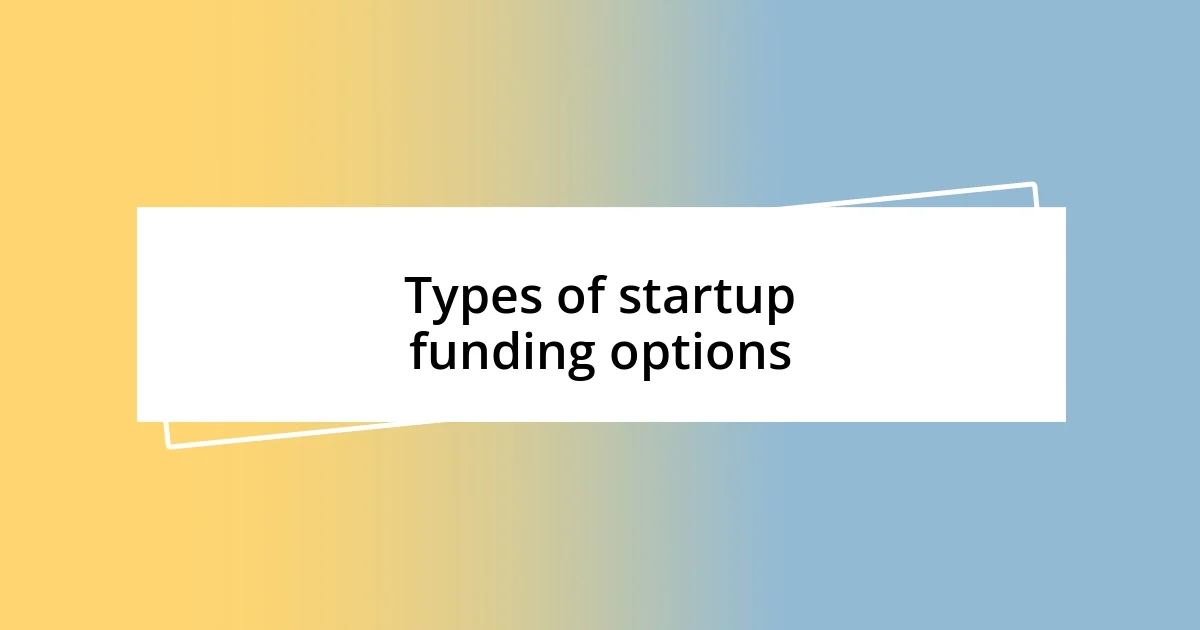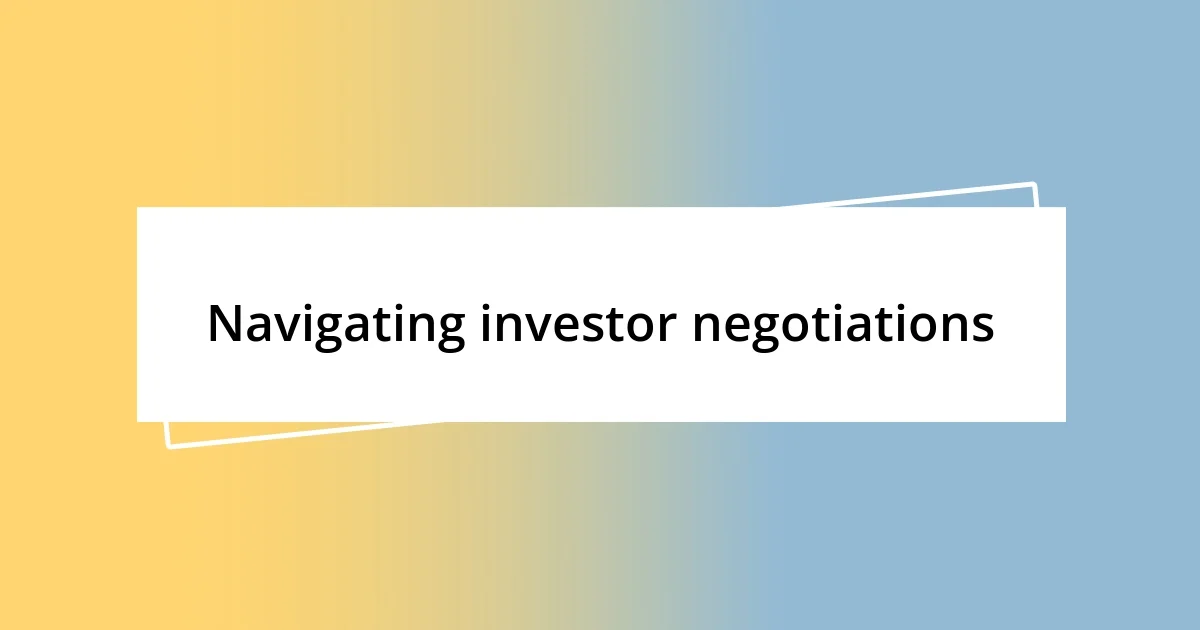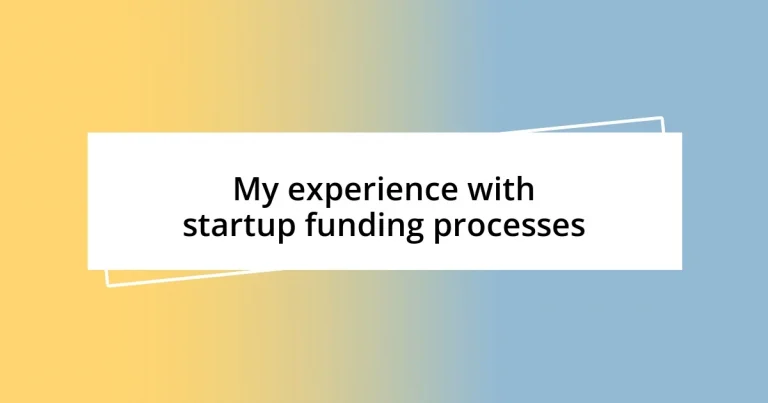Key takeaways:
- Understanding various funding options (bootstrapping, angel investors, venture capitalists) is crucial for startups, each with unique advantages and challenges.
- Crafting a compelling narrative combined with a solid business plan enhances pitches, connecting emotionally with investors while demonstrating financial insight.
- Building relationships and managing expectations is essential; clear communication, flexibility during negotiations, and resilience in the face of rejection are key to successful funding experiences.

Understanding startup funding basics
When I first delved into the world of startup funding, I quickly realized how vital it is to understand different funding stages, from seed capital to Series A and beyond. Each phase plays a crucial role in growth, but they come with unique expectations and challenges. Have you ever felt overwhelmed by the amount of information out there? I certainly did.
In my early days, I remember sitting in a café, pouring over countless articles about venture capitalists and angel investors. It struck me how essential it is for founders to not only secure funds but also to build relationships with these financial backers. That connection often matters more than the money itself; it’s about finding someone who believes in your vision as much as you do.
The emotional rollercoaster of securing funding is real. Rejections can sting deeply, and celebrating small wins often feels bittersweet in a world where millions are at stake. Yet, navigating these processes taught me resilience and the importance of staying adaptable. How do you cope with such highs and lows? For me, focusing on the bigger picture and remembering the passion behind the startup kept me grounded.

Types of startup funding options
When exploring the different types of funding options, I discovered there’s a spectrum that can suit various needs and stages of a startup. It’s not just about the money; each option connects differently with your entrepreneurial journey. For instance, I once faced the choice between bootstrapping and seeking angel investment. The former felt like a tightrope walk, while the latter introduced me to mentors whose insights became invaluable.
Here are some common startup funding options I encountered:
- Bootstrapping: Using personal savings or revenue to fund your startup; it’s empowering, but can be limiting.
- Angel Investors: High-net-worth individuals who invest their own money; they often provide guidance too.
- Venture Capitalists (VCs): Professional investors who manage funds; they usually expect significant returns and can push for control.
- Crowdfunding: Raising small amounts from many people, often through platforms like Kickstarter; it can also validate your idea.
- Government Grants and Loans: Funding provided by governmental bodies; these can come with strict eligibility criteria but offer non-dilutive capital.
Reflecting on my early experiences, I can almost feel the apprehension of seeking the right kind of funding. Each option came with its own set of challenges. One time, I saw a startup I admired thrive after taking a leap into crowdfunding. The thrill of engaging directly with potential customers was something I hadn’t anticipated but was intoxicating. It’s those moments of connection—where funding meets community—that truly stand out in this journey.

Preparing your startup for funding
Preparing your startup for funding requires a blend of strategic planning and heartfelt storytelling. When I considered my pitch, I realized that clarity is key. Potential investors want to understand not only what your startup does but also why it matters. It became apparent to me that a compelling narrative about my mission, combined with a robust business model, could make a difference. Have you found that storytelling resonates with your audience? I certainly have, as it helped me create a stronger emotional bond with investors.
Creating a solid business plan was a turning point for my startup. During those formative days, I crafted a comprehensive document that outlined not just our goals, but the steps we would take to achieve them. I recall many late nights discussing financial projections and market analysis with my team. These discussions revealed our strengths and weaknesses, allowing us to refine our pitch. Investing time in this preparation ensured that when the moment came for an investor meeting, I felt confident and well-prepared.
Understanding your financial needs is another crucial element. When I was preparing for funding, I scrutinized every detail of our budget. This diligence paid off when an investor asked, “How much are you really looking for, and why?” I had a clear number and a solid reasoning behind it. What about you? Have you calculated your runway and expenses? If not, I highly recommend it, as having this figure ready shows potential backers that you truly understand your business.
| Preparation Step | Importance |
|---|---|
| Crafting a Compelling Narrative | Helps establish emotional connections with investors |
| Developing a Solid Business Plan | Ensures clarity in your goals and operational steps |
| Understanding Financial Needs | Demonstrates financial insight and instills confidence in investors |

Crafting an effective pitch
Crafting an effective pitch is all about clarity and connection. I vividly remember the first time I stood before investors, my heart racing. I realized that the numbers and statistics were essential, but it was the story behind my startup that truly captivated their interest. Has your idea ever felt like a part of you? Sharing the passion and purpose behind your venture can strike a chord that mere facts often can’t.
As I honed my pitch, I paid careful attention to the structure. I found that starting with a compelling hook engaged listeners right away. For instance, I shared a personal experience related to the problem my startup aimed to solve. The transformation from a relatable challenge into a solution made the pitch come alive. Have you thought about how your own journey intertwines with your business? My own narrative made the pitch feel authentic, and I could see it resonate with investors.
Balancing emotion with data was another key snag I encountered. One time during a crucial pitch, I presented enthusiastic projections, but when pressed on details, I faltered. After that meeting, I learned that having key performance metrics on hand built trust. Have you ever been in a situation where you felt the gap between passion and preparedness? I now understand the harmony needed between heartfelt storytelling and solid analytics—it’s this blend that creates a pitch that truly stands out.

Navigating investor negotiations
Negotiating with investors can be daunting, but I discovered that understanding their perspective is key. During one intense negotiation, I truly listened to what the investors were looking for—alignment with their vision and expected returns. I realized the importance of rapport; building a connection made them more open to my ideas. Have you ever found that a genuine conversation can change the course of a meeting? For me, it transformed potential skepticism into enthusiasm.
Another vital aspect I found was the art of compromise. During a negotiation, I had to reconcile my demands with what the investors were willing to offer. I recall one instance where I sought a higher equity stake than they were comfortable with, and it was through an open discussion that we reached a middle ground. This taught me that being flexible not only preserves relationships but can lead to better long-term partnerships. Have you evaluated your non-negotiables? Knowing where you can give a little can make all the difference.
Lastly, clarity in communication is essential every step of the way. When engaged in discussions, I made it a priority to express my aspirations and vision straightforwardly. I remember simplifying technical jargon into accessible language. This practice not only kept the conversation flowing but also ensured that everyone was on the same page. Have you found that simplifying your message can elevate understanding? I certainly believe that clear communication often lays the foundation for successful negotiations and further industry relationships.

Managing funding round expectations
I learned that managing expectations during funding rounds is crucial for maintaining both motivation and morale. Early on, I had this soaring hope that every conversation would lead to a guaranteed investment, but the reality hit hard when many discussions fizzled out. Have you ever felt that excitement only to face the letdown? It taught me to temper my enthusiasm with a dose of realism. Setting clear milestones helped guide my focus, and I found it essential to remain flexible.
Another lesson I picked up was to actively communicate with my team about the funding process. During our first round, I noticed that everyone had varying expectations about the timeline and outcomes. Openly discussing what each stage meant made us a cohesive unit and minimized stress during moments of uncertainty. Have you checked in with your team’s thoughts lately? Creating an environment of transparency fostered trust and allowed us to celebrate small wins together, even when we were still far from securing major funding.
Lastly, I discovered the importance of managing investor expectations, too. There was a point when I misjudged how much information to share, thinking complete transparency would bolster trust. Instead, I learned it can also spark unnecessary concern. Balancing the disclosure of challenges while staying optimistic about the future objective became vital. Have you reflected on how much detail to share with your investors? I’ve found that guiding them through the journey, while skillfully managing the narrative, built a stronger sense of partnership in the funding process.

Lessons learned from funding experiences
Fundraising is an emotional rollercoaster, and one key lesson I’ve learned is to prepare for the unexpected ups and downs. I vividly recall a moment where I felt sure about an impending investment, only to have it slip through my fingers at the last minute. That experience made me realize that resilience is as crucial as a solid business plan. How do you handle disappointment when things don’t go your way? For me, developing a strategy to bounce back helped keep my motivation alive.
A significant takeaway for me was the value of building relationships beyond financial transactions. During one pitch, I connected with an investor over our shared passion for sustainable innovation. This bond not only improved our working relationship but also enriched my startup’s vision moving forward. Have you considered how personal connections can impact funding? I found that nurturing these relationships often leads to valuable advice and support well beyond the check they might write.
Moreover, I learned that persistence pays off, especially in the face of rejection. I fondly remember a day when I received multiple “no’s” from potential investors, feeling a weight on my spirit. It wasn’t easy, but I decided to reach out to them again after refining my pitch. Eventually, one of those investors came back and expressed renewed interest. Have you thought about how taking the time to iterate can change perspectives? This taught me that every “no” can be an opportunity for growth, reinforcing the idea that the funding journey is as much about tenacity as it is about strategy.














